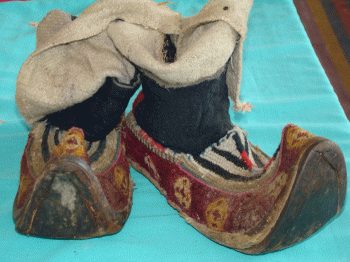Know Your Culture
Oct 30, 2018

Pabu, the traditional shoe
Ladakhi traditional shoes called ‘Pabu’ are designed to be used in a manner that is uniquely adapted to the landscape and weather condition of the region. The traditional shoe is made from woven yak hair or wool and is often decorated with yak leather.
The shoes are originated from Ladakh itself. It is also believed that the air between the laces is scientifically ground to keep warm in the winter and in the summer. Shoe soles are designed to protect footwear from external influences. The top of the Papu stockings is traditionally made using the Nambu (local textile or worsted wool).
The soles of the ‘Pabu’ are decorated with yak and horse leather. The backside of the shoe is a piece of cloth that is used to stabilize and support the foot.
The 'Pabu' is made by using every conceivable detail, the cover above the shoes is made of Nambu with flower embroidery. The curved toe of the shoe is designed to give shape to the same and to make it look more elegant. Pabu of kings and queens, noblemen and high-ranking monks were beautifully stitched and well designed.
Ladakhis have long been making and wearing ‘Pabu’, known as Thikma. Before that, there were other types and design like the Khulu (yak wool) ‘Pabu’ and ‘Lapul Pabu’. Earlier, people of Ladakh used to wear Khulu (yak wool) shoes and ‘Lapul Pabu’. Later, the people of Nubra valley made Thikma Pabu and added more additional design to make it look more beautiful. Also, the people of Sham valley were into making this Pabu and were made with using various colours of Snambu.
With the trend of Thikma Pabu, Khulu (yak wool) and ‘Lapul Pabu’ lost its grace and people were seen using it very less. The ‘Pabu’ was worn throughout the year. With time different other shoes were also introduced. Kabsha was among one of that which had zari work imported from Pakistan. Sooner Thikma pabu lost it charm and people were seen wearing other types of shoes.
Now, the ‘Thikma Pabu’ is entirely used by the traditional dancers.
Courtesy: Padma Angmo Nochung





